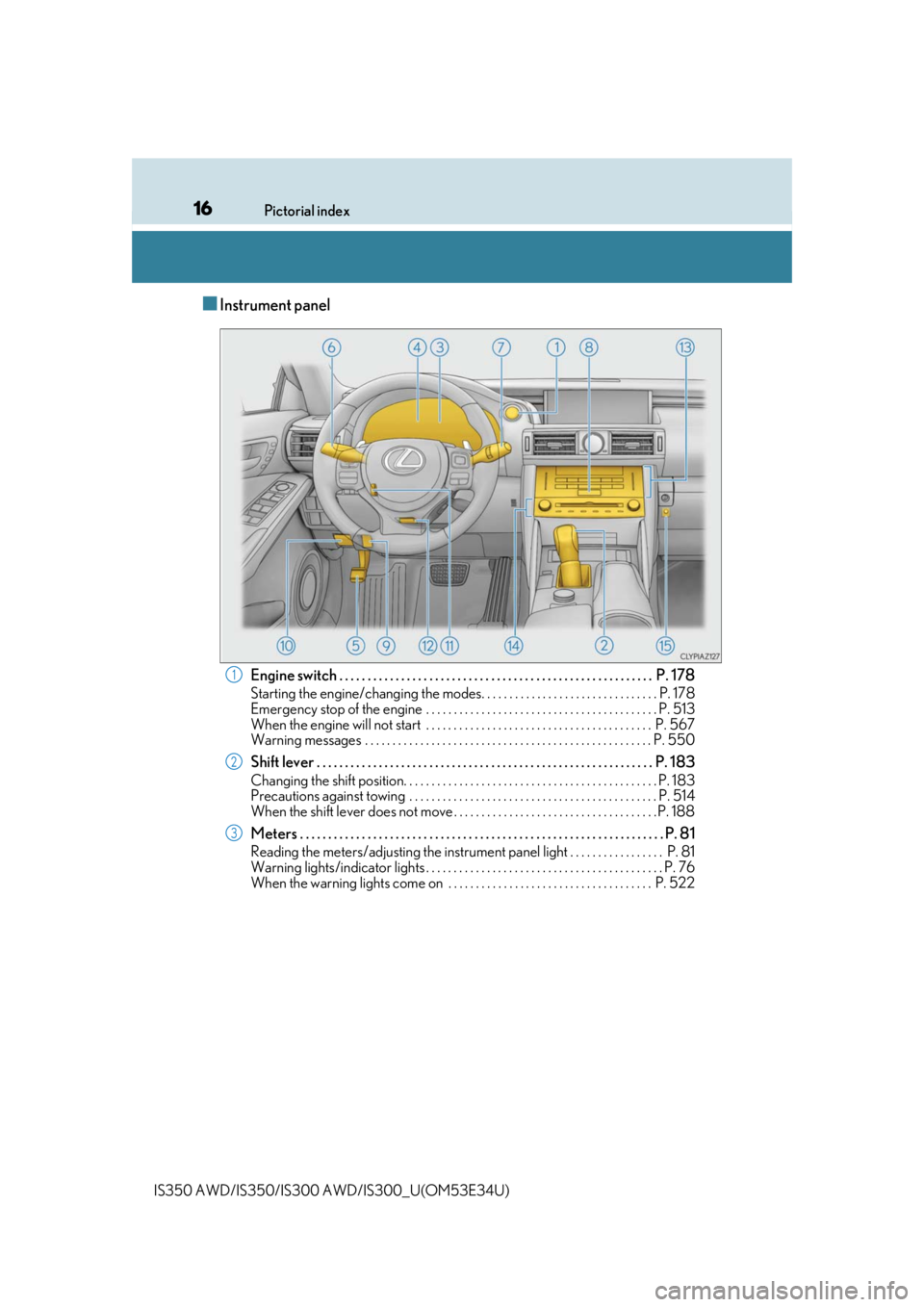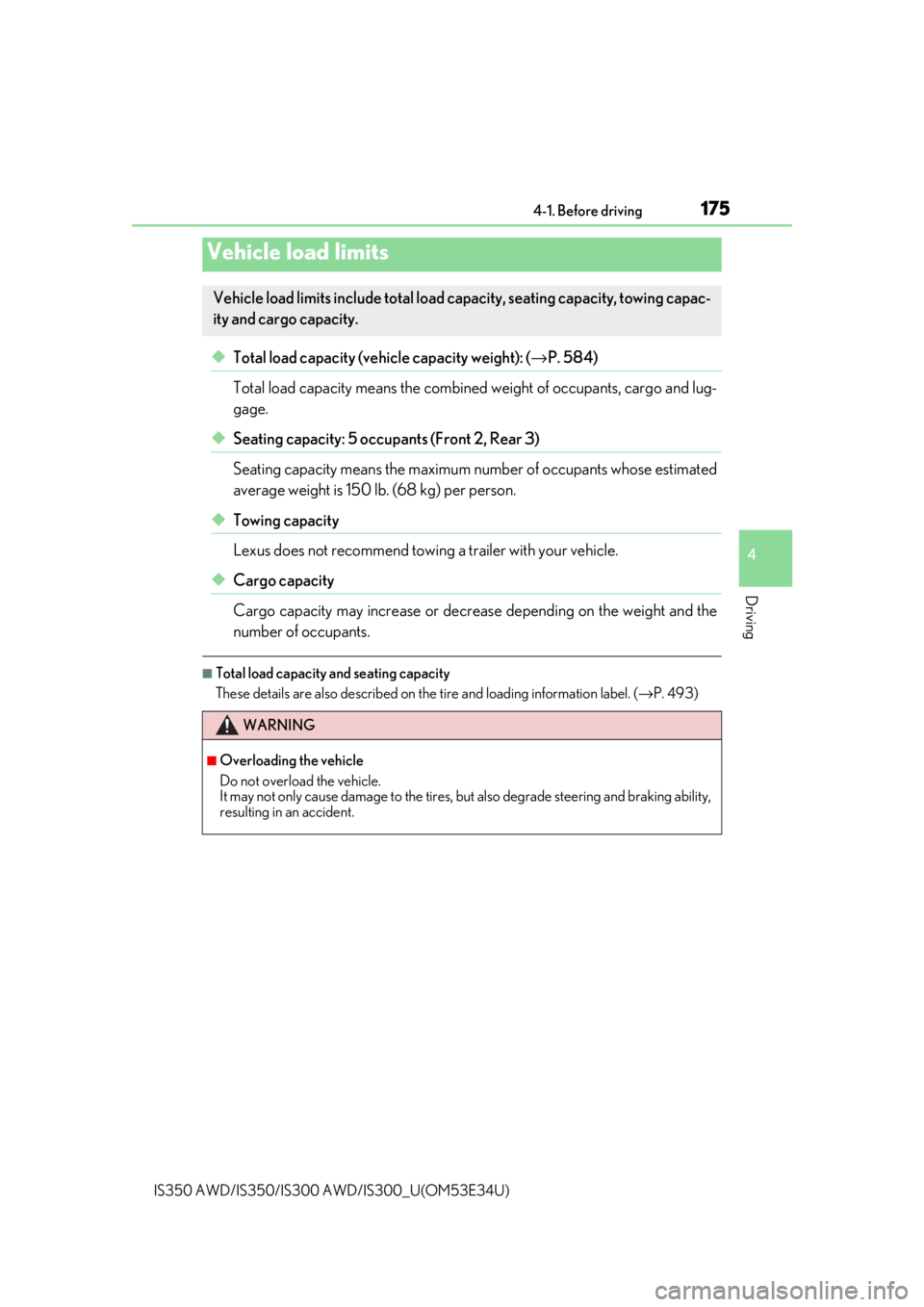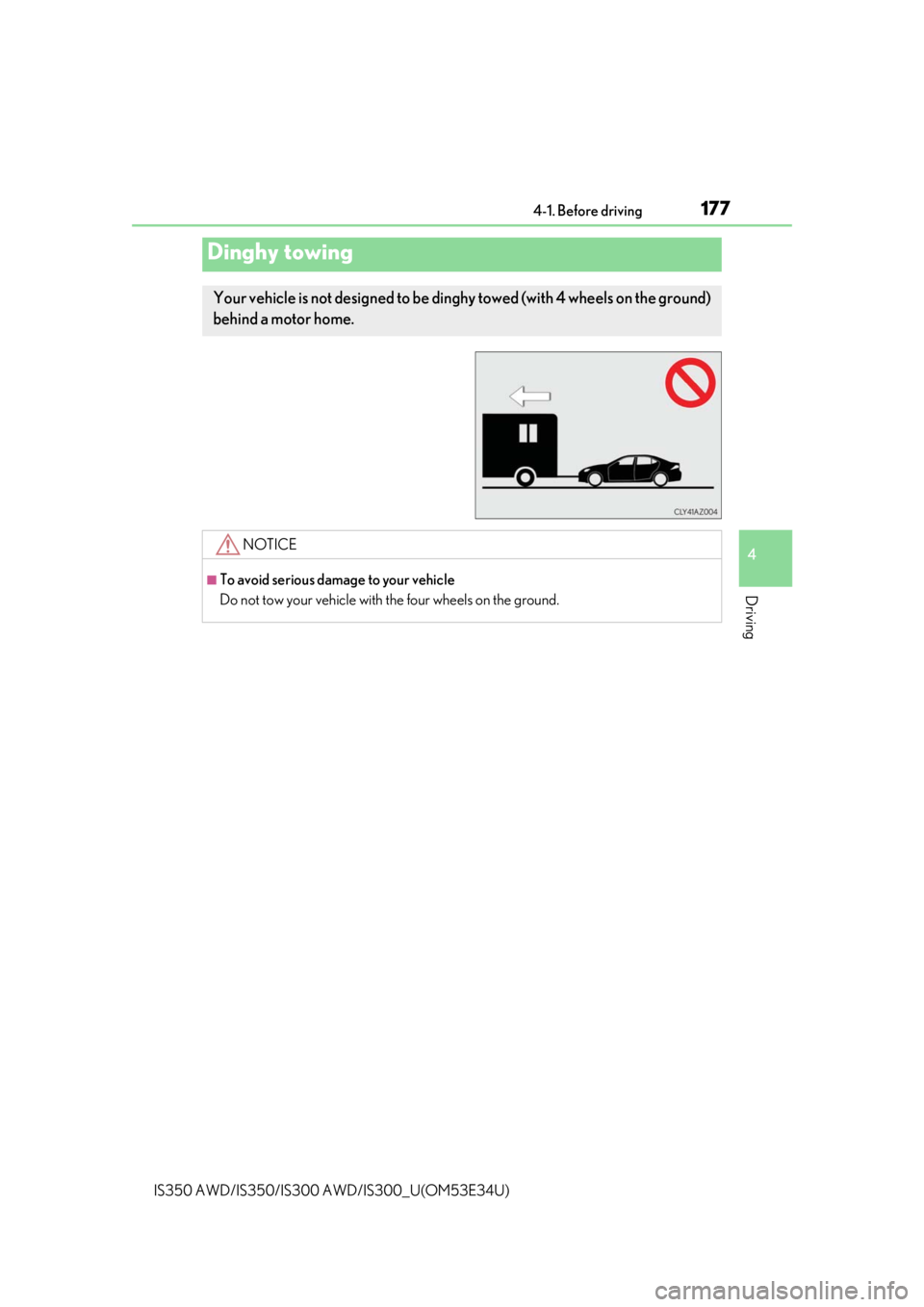towing Lexus IS300 2018 Owner's Manual / LEXUS 2018 IS300,IS350 OWNER'S MANUAL (OM53E34U)
[x] Cancel search | Manufacturer: LEXUS, Model Year: 2018, Model line: IS300, Model: Lexus IS300 2018Pages: 656, PDF Size: 10.37 MB
Page 3 of 656

3
1
9 8
7 5 4
3
2
10
IS350 AWD/IS350/IS300 AWD/IS300_U(OM53E34U)
6
4-1. Before driving
Driving the vehicle ......................164
Cargo and luggage .................... 172
Vehicle load limits .......................175
Trailer towing ................................ 176
Dinghy towing ............................... 177
4-2. Driving procedures Engine (ign ition) switch .............178
Automatic transmission ........... 183
Turn signal lever .......................... 190
Parking brake ................................192
ASC (Active Sound Control) .........193
4-3. Operating the lights and wipers
Headlight switch ..........................194
Automatic High Beam.............. 198
Windshield wipers and washer ......................................... 202
4-4. Refueling Opening the fuel tank cap ...... 210 4-5. Using the driving support
systems
Lexus Safety System+ ................ 214
PCS (Pre-Collision System) ........... 221
LDA (Lane Departure Alert with steering co ntrol) ............ 232
Dynamic radar cruise control ......................................... 239
Intuitive parking assist................251
Lexus parking assist monitor........................................ 260
BSM (Blind Spot Monitor)......276
• BSM function.........................280
• RCTA function...................... 283
Driving mode select switch ...........................................288
Driving assist systems .............. 292
4-6. Driving tips Winter driving tips..................... 297
4Driving
Page 16 of 656

16Pictorial index
IS350 AWD/IS350/IS300 AWD/IS300_U(OM53E34U)
■Instrument panel
Engine switch . . . . . . . . . . . . . . . . . . . . . . . . . . . . . . . . . . . . . . . . . . . . . . . . . . . . . . . . P . 178
Starting the engine/changing the modes. . . . . . . . . . . . . . . . . . . . . . . . . . . . . . . . P. 178
Emergency stop of the engine . . . . . . . . . . . . . . . . . . . . . . . . . . . . . . . . . . . . . . . . . . P. 513
When the engine will not start . . . . . . . . . . . . . . . . . . . . . . . . . . . . . . . . . . . . . . . . . P. 567
Warning messages . . . . . . . . . . . . . . . . . . . . . . . . . . . . . . . . . . . . . . . . . . . . . . . . . . . . P. 550
Shift lever . . . . . . . . . . . . . . . . . . . . . . . . . . . . . . . . . . . . . . . . . . . . . . . . . . . . . . . . . . . . P. 183
Changing the shift position. . . . . . . . . . . . . . . . . . . . . . . . . . . . . . . . . . . . . . . . . . . . . . P. 183
Precautions against towing . . . . . . . . . . . . . . . . . . . . . . . . . . . . . . . . . . . . . . . . . . . . . P. 514
When the shift lever does not move . . . . . . . . . . . . . . . . . . . . . . . . . . . . . . . . . . . . . P. 188
Meters . . . . . . . . . . . . . . . . . . . . . . . . . . . . . . . . . . . . . . . . . . . . . . . . . . . . . . . . . . . . . . . . . P. 81
Reading the meters/adjusting the instrument panel light . . . . . . . . . . . . . . . . . P. 81
Warning lights/indicator lights . . . . . . . . . . . . . . . . . . . . . . . . . . . . . . . . . . . . . . . . . . . P. 76
When the warning lights come on . . . . . . . . . . . . . . . . . . . . . . . . . . . . . . . . . . . . . P. 522
1
2
3
Page 163 of 656

163
Driving4
IS350 AWD/IS350/IS300 AWD/IS300_U(OM53E34U)
4-1. Before driving
Driving the vehicle ...................... 164
Cargo and luggage .................... 172
Vehicle load limits ....................... 175
Trailer towing ................................ 176
Dinghy towing ...............................177
4-2. Driving procedures Engine (ignition) switch ............ 178
Automatic transmission............ 183
Turn signal lever........................... 190
Parking brake ............................... 192
ASC (Active Sound Control)......... 193
4-3. Operating the lights and wipers
Headlight switch .......................... 194
Automatic High Beam .............. 198
Windshield wipers and washer..........................................202
4-4. Refueling Opening the fuel tank cap....... 210 4-5. Using the driving support
systems
Lexus Safety System+ ................214
PCS (Pre-Collision System) ...........221
LDA (Lane Departure Alert with steering control) ............ 232
Dynamic radar cruise control ......................................... 239
Intuitive parking assist ............... 251
Lexus parking assist monitor ........................................ 260
BSM (Blind Spot Monitor) ..... 276
• BSM function .........................280
• RCTA function......................283
Driving mode select switch .......................................... 288
Driving assist systems .............. 292
4-6. Driving tips Winter driving tips ..................... 297
Page 172 of 656

1724-1. Before driving
IS350 AWD/IS350/IS300 AWD/IS300_U(OM53E34U)
Cargo capacity depends on the total weight of the occupants.
(Cargo capacity) = (Total load capac ity) — (Total weight of occupants)
Steps for Determining Correct Load Limit —
(1) Locate the statement “The combined weight of occupants and cargo should
never exceed XXX kg or XXX lbs. ” on your vehicle’s placard.
(2) Determine the combined weight of th e driver and passengers that will be rid-
ing in your vehicle.
(3) Subtract the combined weight of th e driver and passengers from XXX kg or
XXX lbs.
(4) The resulting figure equals the ava ilable amount of cargo and luggage load
capacity.
For example, if the “XXX” amount equals 1400 lbs. and there will be five 150
lb passengers in your vehicle, the amou nt of available cargo and luggage load
capacity is 650 lbs. (1400 − 750 (5 × 150) = 650 lbs.)
(5) Determine the combined weight of luggage and cargo being loaded on the
vehicle. That weight may not safely exceed the available cargo and luggage
load capacity calculated in Step 4.
(6) If your vehicle will be towing a trailer, load from your trailer will be transferred
to your vehicle. Consult this manual to determine how this reduces the avail-
able cargo and luggage load capacity of your vehicle.
(→ P. 175)
Lexus does not recommend towing a trailer with your vehicle. Your vehicle is not
designed for trailer towing.
Cargo and luggage
Take notice of the following informat ion about storage precautions, cargo
capacity and load:
Capacity and distribution
Page 175 of 656

1754-1. Before driving
4
Driving
IS350 AWD/IS350/IS300 AWD/IS300_U(OM53E34U)
◆Total load capacity (vehicle capacity weight): ( →P. 584)
Total load capacity means the combined weight of occupants, cargo and lug-
gage.
◆Seating capacity: 5 occupants (Front 2, Rear 3)
Seating capacity means the maximum number of occupants whose estimated
average weight is 150 lb. (68 kg) per person.
◆Towing capacity
Lexus does not recommend towing a trailer with your vehicle.
◆Cargo capacity
Cargo capacity may increase or decrease depending on the weight and the
number of occupants.
■Total load capacity and seating capacity
These details are also described on the tire and loading information label. (→P. 493)
Vehicle load limits
Vehicle load limits include total load capacity, seating capacity, towing capac-
ity and cargo capacity.
WARNING
■Overloading the vehicle
Do not overload the vehicle.
It may not only cause damage to the tires, but also degrade steering and braking ability,
resulting in an accident.
Page 176 of 656

1764-1. Before driving
IS350 AWD/IS350/IS300 AWD/IS300_U(OM53E34U)
Trailer towing
Lexus does not recommend towing a trailer with your vehicle. Lexus also does
not recommend the installation of a tow hitch or the use of a tow hitch carrier
for a wheelchair, scooter, bicycle, etc. Your vehicle is not designed for trailer
towing or for the use of tow hitch mounted carriers.
Page 177 of 656

1774-1. Before driving
4
Driving
IS350 AWD/IS350/IS300 AWD/IS300_U(OM53E34U)
Dinghy towing
Your vehicle is not designed to be dinghy towed (with 4 wheels on the ground)
behind a motor home.
NOTICE
■To avoid serious damage to your vehicle
Do not tow your vehicle with the four wheels on the ground.
Page 224 of 656

2244-5. Using the driving support systems
IS350 AWD/IS350/IS300 AWD/IS300_U(OM53E34U)
WARNING
■When to disable the pre-collision system
In the following situations, disable the system, as it may not operate properly, possibly
leading to an accident resultin g in death or serious injury:
●When the vehicle is being towed
●When your vehicle is towing another vehicle
●When transporting the vehicle via truck, bo at, train or similar means of transportation
●When the vehicle is raised on a lift with the engine running and the tires are allowed to
rotate freely
●When inspecting the vehicle using a drum tester such as a chassis dynamometer or
speedometer tester, or when using an on vehicle wheel balancer
●When a strong impact is applied to the fron t bumper or front grille, due to an accident
or other reasons
●If the vehicle cannot be driven in a stable manner, such as when the vehicle has been
in an accident or is malfunctioning
●When the vehicle is driven in a sporty manner or off-road
●When the tires are not properly inflated
●When the tires are very worn
●When tires of a size other than specified are installed
●When tire chains are installed
●When a compact spare tire or an emergency tire puncture repair kit is used
●If equipment (snow plow, etc.) that may obstruct the radar sensor or camera sensor is
temporarily installed to the vehicle
Page 241 of 656

2414-5. Using the driving support systems
4
Driving
IS350 AWD/IS350/IS300 AWD/IS300_U(OM53E34U)
WARNING
■Situations unsuitable for dynamic radar cruise control
Do not use dynamic radar cruise contro l in any of the following situations.
Doing so may result in inappropriate speed control and could cause an accident result-
ing in death or serious injury.
●Roads where there are pede strians, cyclists, etc.
●In heavy traffic
●On roads with sharp bends
●On winding roads
●On slippery roads, such as thos e covered with rain, ice or snow
●On steep downhills, or where there are sudden changes between sharp up and down
gradients
Vehicle speed may exceed the set speed when driving down a steep hill.
●At entrances to freeways and highways
●When weather conditions are bad enough that they may prevent the sensors from
detecting correctly (fog, snow, sandstorm, heavy rain, etc.)
●When there is rain, snow, etc. on the fron t surface of the radar sensor or camera sen-
sor
●In traffic conditions that require frequent repeated a cceleration and deceleration
●During emergency towing
●When an approach warning buzzer is heard often
Page 258 of 656

2584-5. Using the driving support systems
IS350 AWD/IS350/IS300 AWD/IS300_U(OM53E34U)
WARNING
■When using the intuitive parking assist
Observe the following precautions.
Failing to do so may result in the vehicle be ing unable to be driven safely and possibly
cause an accident.
●Do not use the sensor at speeds in excess of 6 mph (10 km/h).
●The sensors’ detection areas and reaction ti mes are limited. When moving forward or
reversing, check the areas surrounding the vehicle (especially the sides of the vehi-
cle) for safety, and drive slowly, using the brake to control the vehicle’s speed.
●Do not install accessories within the sensors’ detection areas.
■Sensor detection information
●The sensor’s detection areas are limited to the areas around the vehicle’s bumper.
●Certain vehicle conditions and surrounding environments, such as the following, may
affect the ability of the sensors to correctly detect obje cts. Pay particular attention in
the following situations. Failure to do so may result in the vehicle being driven
unsafely, possibly leading to an accident.
• There is dirt, snow or ice on the sensor . (Wiping the sensors will resolve this prob-
lem.)
• The sensor is frozen. (Thawing th e area will resolve this problem.)
In especially cold weather, if a sensor is frozen the screen may show an abnormal
display, or obstacles may not be detected.
• The sensor is covered in any way.
• The vehicle is leaning considerably to one side.
• On an extremely bumpy road, on an incline, on gravel, or on grass.
• The vicinity of the vehicle is noisy due to vehicle horns, motorcycle engines, air brakes of large vehicles, or other loud noises producing ultrasonic waves.
• There is another vehicle equipped with parking assist sensors in the vicinity.
• The sensor is coated with a sheet of spray or heavy rain.
• The vehicle is equipped with a fender pole or wireless antenna.
• Towing eyelets are installed.
• The bumper or sensor receives a strong impact.
• The vehicle is approaching a tall or curved curb.
• In harsh sunlight or intense cold weather.
• The area directly under the bumpers is not detected.
• If obstacles draw too close to the sensor.
• A non-genuine Lexus suspension (low ered suspension etc.) is installed.
• People may not be detected if they are wearing certain types of clothing.
In addition to the examples above, there are instances in which, because of their
shape, signs and other objects may be judged by a sensor to be closer than they are.